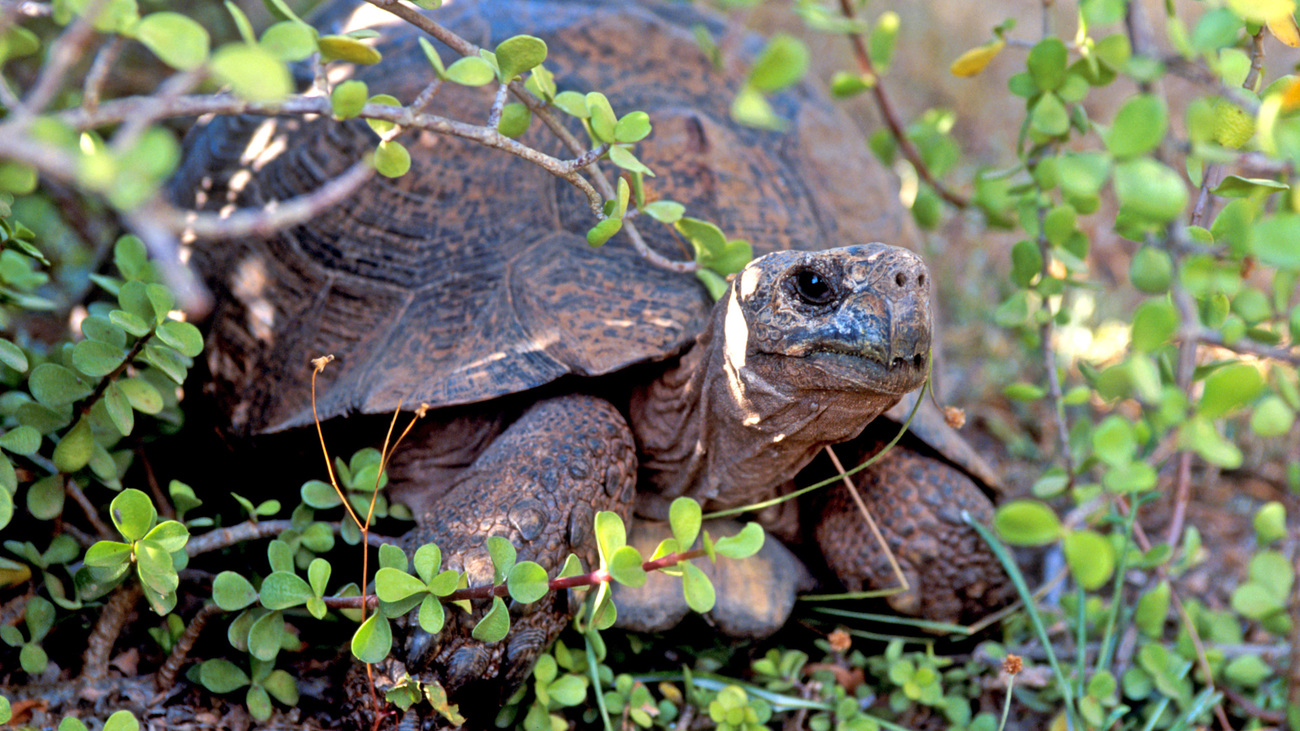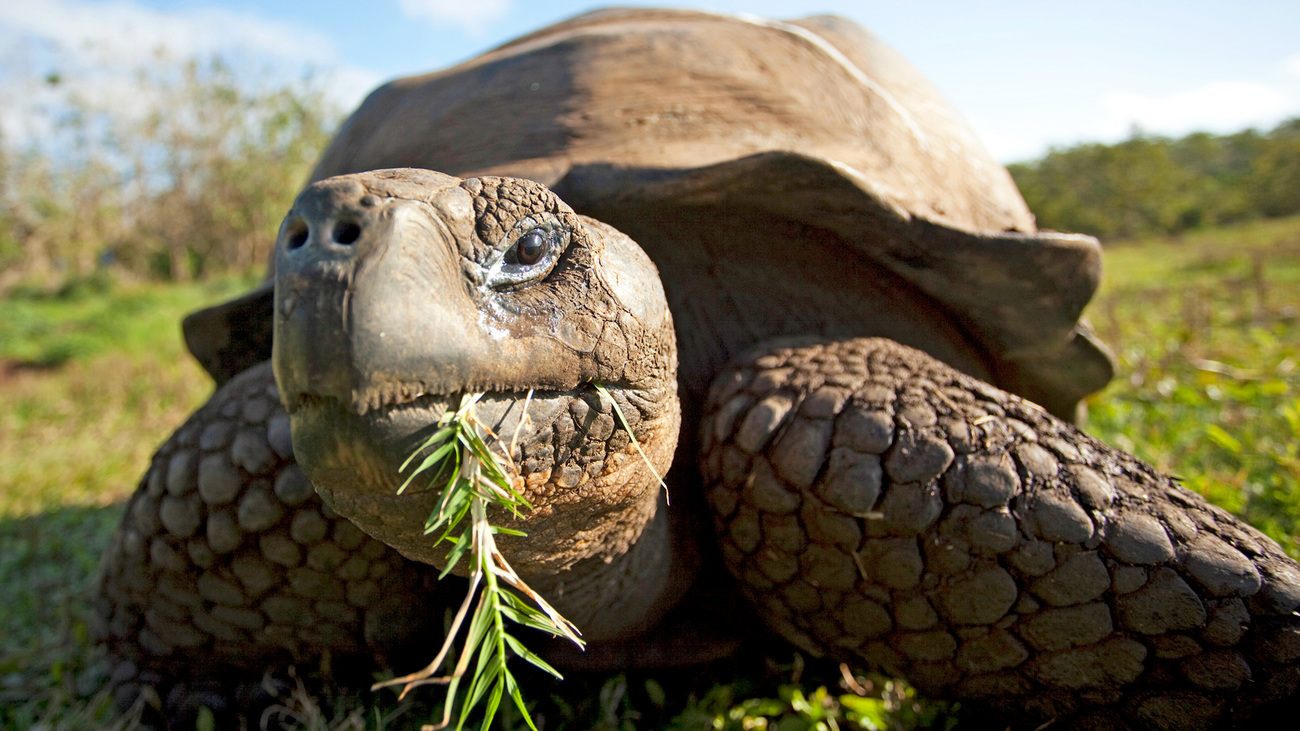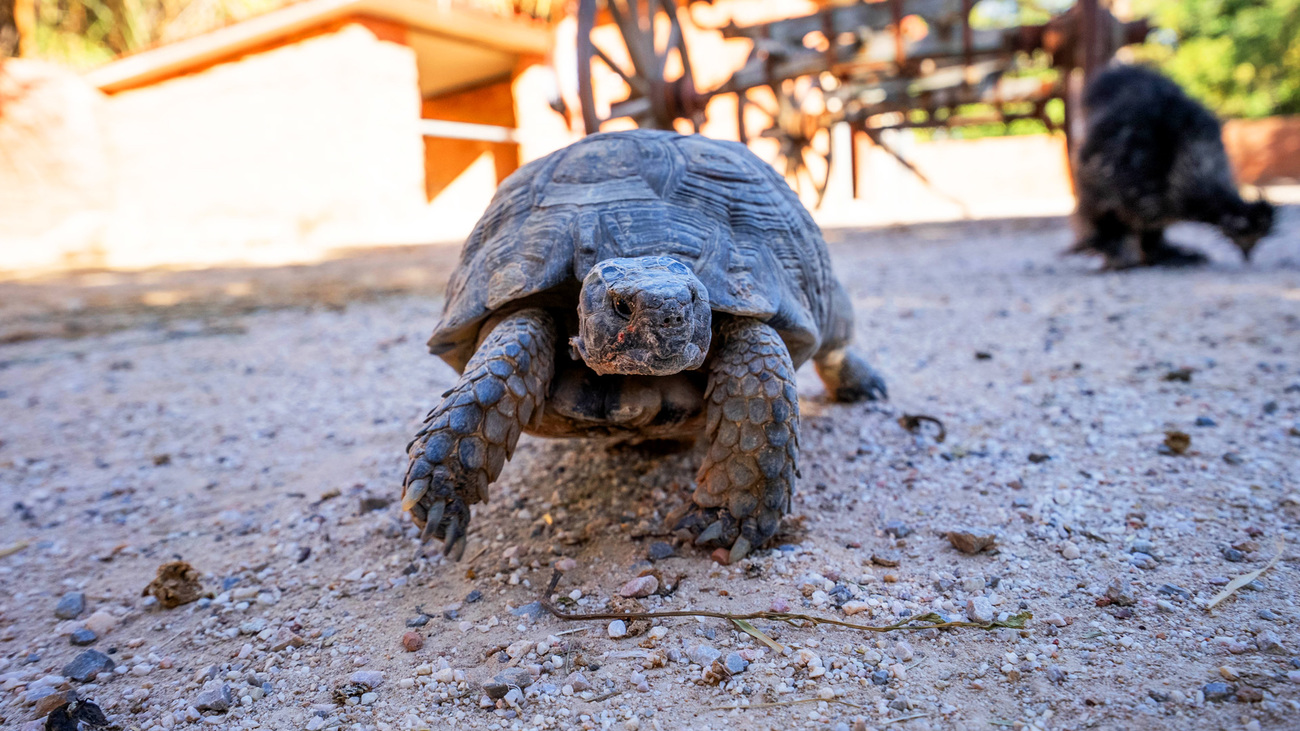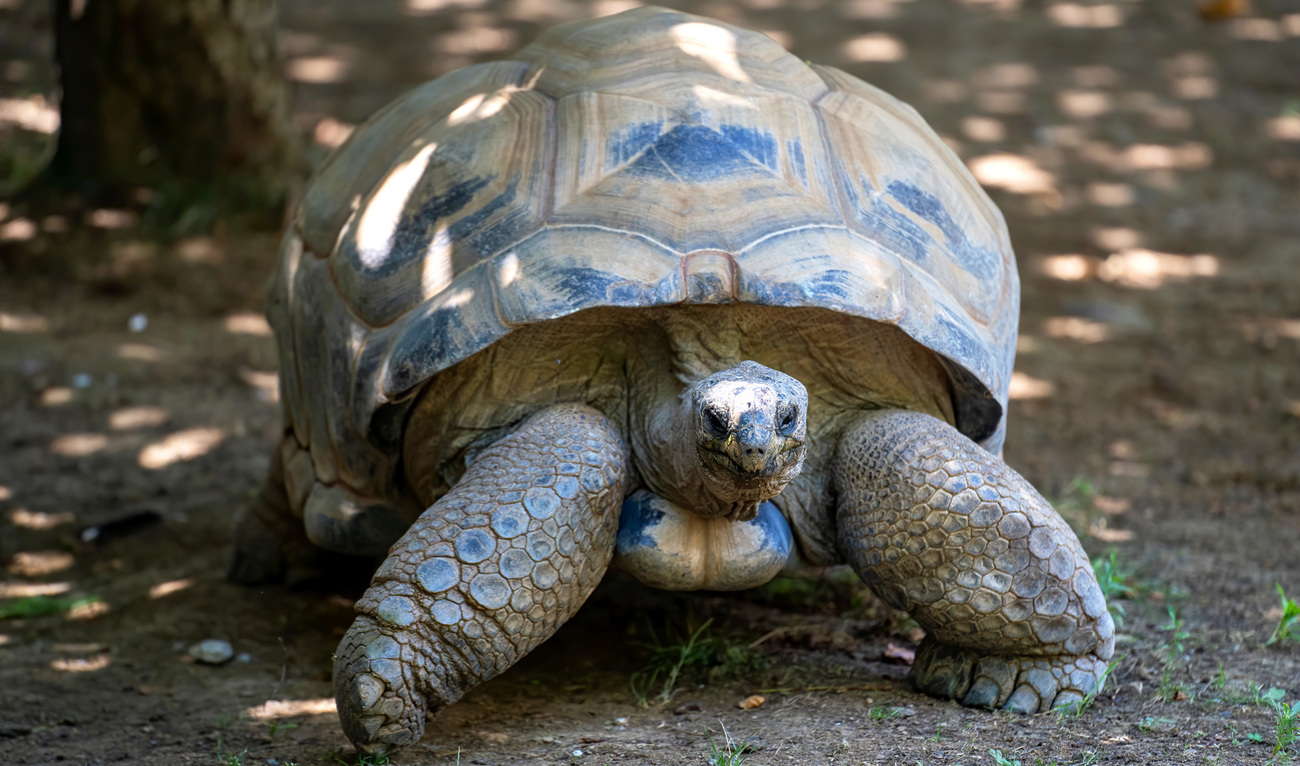Tortoises
Tortoises are ancient creatures that have been around for more than 230 million years. This means that these fascinating animals from the family Testudinidae coexisted with dinosaurs and are among the oldest living animal groups on Earth. Their incredible longevity and ability to survive through various geologic eras make tortoises an important and often overlooked part of evolutionary history.
While all tortoises are turtles, not all turtles are classified as tortoises. This distinction is drawn based on several unique physical attributes that set them apart from other members of the turtle family.
The term tortoise is believed to originate from the Latin word tortus, which means ‘twisted’. This is likely a reference to their bent legs, one of the unique features that differentiate them from other turtle species. Their sturdy limbs are designed for terrestrial life rather than swimming, meaning tortoises spend their entire lives on the ground, unlike turtles, which are often water-based.
In addition to their legs, tortoises also have a number of other characteristics designed for terrestrial life. Tortoises have dome-shaped shells with high arches, in stark contrast to the streamlined shells often seen in sea-dwelling or semi-aquatic turtles. A tortoise’s shell serves both as a means of protection and as a way of aiding in body temperature regulation and hydration.
Tortoises have column-like hind legs and elephantine front legs suited for locomotion on solid ground. They are also equipped with sharp claws that allow them to easily dig burrows and traverse different terrains.
How long do tortoises live?
One thing that tortoises are known for is their impressive lifespans, with reports of some tortoises living for up to 200 years! One well-known example is a tortoise named Harriet. She was captured by Charles Darwin during his travels in 1835 and spent her later years under the care of wildlife expert Steve Irwin. When she passed away in 2006, it was estimated that she had lived for around 175 years.
Another notable physical attribute is the curvature of the underside of a tortoise’s shell, also called a plastron. This, coupled with the size of the tortoise, is the best way to distinguish between male and female tortoises. Males usually have a concave plastron which helps them balance on top of females during mating.
Although this helps them balance, male tortoises face unique challenges when mating due to the high-domed shells that female tortoises have. This unusual body structure means that mating for tortoises is an intricate process that requires patience.
Once successful mating does occur, female tortoises lay small clutches of eggs. These clutches are often fewer than twenty eggs at a time, and tortoises bury them in sandy or soft soil where they incubate naturally through heat generated from sunlight. Some smaller tortoise species may produce even fewer eggs per clutch, sometimes as low as five.
This incubation period can last for 60-120 days before the hatchlings begin to emerge from their eggs. Hatchlings have a temporary tooth called a caruncle, which they use to break the eggshell from the inside. This is a slow process and can take several days.
Unfortunately, the survival rate for tortoise hatchlings is quite low. Many of them are preyed upon by birds and other predators soon after they hatch. In some species, it has been estimated that only 2-5% of tortoise hatchlings will reach adulthood. Part of this low survival rate is because adult tortoises do not provide parental care, with hatchlings being left to fend for themselves as soon as they emerge.
Tortoises that do reach adulthood are extremely versatile, able to thrive in many types of environments around the world. You’ll find them living in habitats as varied as dry deserts to tropical forests. These habitats can be found across most continents—tortoises live on every major landmass except Australia and Antarctica.
Tortoises are primarily herbivorous, eating mainly leaves, flowers, and fruits. Not all tortoises stick to a vegetarian diet, though; the species that live in damper forest regions occasionally consume animal matter.
There is a lot of variation in size between species. Some hatchlings may start out as tiny as 2.5 centimetres (1 inch) in length, and some adults can grow to be up to 1.8 metres (6 feet) in length and weigh as much as 259 kilograms (570 pounds).
There is evidence to show that tortoises are very intelligent. They have been known to navigate mazes with surprising accuracy, suggesting that their cognitive abilities may be underestimated. In fact, there has been research that points to tortoises being able to potentially recognise faces and demonstrate memory capabilities.
The long evolutionary history of the tortoise has also led to some interesting adaptations. One example is that instead of excreting only liquid urine, they excrete a semi-solid substance as urates as well. This allows them to retain water for longer periods of time and helps them to survive in dry environments where water is not easily found.
Can tortoises swim?
Tortoises also have a robust respiratory system despite dwelling on land. Due to their lack of webbed feet or flippers, they are unable to swim like turtles, but they have still evolved to have high tolerance levels for carbon dioxide. In practice, this means they are able to hold their breath for long periods of time.
Tortoises play an important ecological role in their environments. Due to the different types of fruits they consume, their droppings disperse seeds and promote plant growth. Digging burrows and nests also helps aerate soil.
What is a tortoise’s scientific name?
All turtle species belong to the family Testudinidae. There are at least 49 living species spread across 15 different genera, so there are many different individual scientific names. Some of the most recognised tortoise species are the African Spurred Tortoise (Centrochelys sulcata), Gopher Tortoise (Gopherus polyphemus), and Aldabra Giant Tortoise (Aldabrachelys gigantea).
Are tortoises endangered?
Given that there are so many different tortoise species, some have a different status than others. According to the IUCN, there are a number of tortoise species with both Critically Endangered and Endangered status.
The Egyptian tortoise, Burmese star tortoise, and Madagascar spider tortoise are among those currently listed as critically endangered, while Agassiz’s desert tortoise, the Galapagos giant tortoise, and the Indian star tortoise are some of the species that are listed as endangered.
Where do tortoises live?
Tortoises are exclusively terrestrial creatures and inhabit a variety of different regions around the world. You’ll find them in a range of diverse habitats from arid deserts to tropical forests. They can be found on all continents except for Australia and Antarctica.
Threats
The two main threats facing tortoises are habitat loss and human activity. While there is some overlap between these issues, they affect tortoise populations in unique ways.

Habitat loss
Habitat loss is a major threat to tortoises. Beyond just losing their homes, tortoises have to deal with the depletion of their primary food sources, as well as exposure to invasive species. When non-native plants are introduced into an area—intentionally or accidentally—they can drastically alter the composition of local flora.
One leading cause of this habitat loss is human construction. As cities and human populations expand, urbanisation encroaches on natural tortoise habitats, fragmenting them and making survival challenging. The expansion of agriculture projects has also caused large amounts of land to be repurposed for farming or grazing livestock, further reducing the available space for tortoises.
On a similar note, deforestation caused by logging and mining activities directly impacts many tortoise species’ habitats. These industries strip away large sections of forests where tortoises live, leaving them vulnerable.
In addition, agricultural runoff and industrial waste can affect the quality of the water sources that tortoises rely on not just for drinking but also for temperature regulation.
The Earth’s changing climate plays a role, too. As temperatures rise and weather patterns shift, habitats become unsuitable for species that previously thrived. For tortoises, this means a potential loss in the vegetation that they rely upon for food and can even affect the patterns of their breeding cycles.
Human activity
Beyond habitat loss, human activity poses significant threats to tortoises worldwide. Given the already low survival rate of hatchlings, human-induced threats like hunting for traditional medicine, the pet trade, and food consumption can all have a devastating impact on the survival of tortoise species.
Tortoises in different regions experience different types of threats posed by human activity. For example, Asia is home to an abundant diversity of tortoise species, and the region faces major issues stemming from exploitation for food and traditional medicine, with the latter largely occurring in China. There has also been a surge in demand within the exotic pet industry, where Indian star tortoises are becoming targeted specifically for their unique shells.
In Africa, and especially Madagascar, local communities extensively consume tortoises for food, leading to dwindling populations. Habitat destruction is another serious issue here, with South African geometric tortoises losing their habitats at alarming rates due to the expansion of human populations.
In Europe, native species like the Hermann’s tortoise and the spur-thighed tortoise are facing declining population numbers. Despite having fewer native species than other continents, Europe remains a hub for the illegal pet trade.
In the Americas, habitat loss, along with international trade targeting tortoises—both as pets and as consumables—poses significant challenges. Species like the desert tortoise and gopher tortoise face a severe risk of extinction unless these problems are solved. As in other regions, tortoise species in America are also struggling against habitat fragmentation caused by urban development. Specifically, practices like ranching or extensive agriculture can lead to overgrazing, which depletes the vegetation on which tortoises rely.
FAQs
How long do tortoises live?
Tortoises have notably long lifespans, often living between 80 to 150 years. Some can surpass this age in captivity under the right care.
What do tortoises eat?
Most tortoises are primarily herbivores, favouring foliage, flowers, and fruits. However, some species, especially those from wetter forest habitats, occasionally consume animal matter.
Are tortoises turtles?
Yes, technically, all tortoises are turtles. The term ‘tortoise’ is used to denote members of the family Testudinidae, which is just one family of turtles. So, while every tortoise is a turtle, not every turtle is a tortoise.

Can tortoises swim?
Tortoises are terrestrial and cannot swim. They may drown if placed in deep water. Despite this, they are capable of holding their breath for long periods of time.
Do tortoises hibernate?
Some tortoise species, particularly those in temperate climates, do hibernate, but this is not common to all species. For those that do, the hibernation period allows them to cope with the colder months.
What is a group of tortoises called?
Most tortoises typically prefer solitude, but when they do form a group, it’s called a ‘creep’. These groups are generally harmonious—there is not much conflict between individual tortoises.
Why are tortoises endangered?
A number of tortoise species are endangered, mainly due to habitat loss and human activity. Human construction, the introduction of invasive species, hunting, vehicle collisions, and exploitation for food, traditional medicine, and the pet trade are all examples of threats that tortoises face. Their slow reproductive cycle makes population recovery challenging.
Our work
IFAW works to protect animals around the world through disaster response, rescue, community engagement, policy, and conservation initiatives.
When wildfires devastated Greece in the summer of 2023, thousands of animals were left sick, injured, and needing veterinary care. Many of their habitats were destroyed. Among these wildlife were over 400 tortoises, which were rescued by volunteers from local NGO Save Your Hood and taken in by IFAW’s local partner ANIMA. To help ANIMA and Save Your Hood assess and care for these tortoises, and prepare them for their release, IFAW deployed a team of experts.
Alongside veterinarians from both partners, our experts, our experts helped determine if tortoises had infections, which involved smelling them. Some tortoises had to undergo extensive treatment.
Together with Save Your Hood, we found a fitting release site and were able to successfully release 201 tortoises back into the wild.

How can you help?
Tortoises are facing threats to their survival from habitat loss and human activity. Learn more about how IFAW is working to protect animals, including tortoises, worldwide.
